| Start of section
Production, amateur Radio amateurs Aircraft model, rocket-model Useful, entertaining |
Stealth Master
Electronics Physics Technologies Inventions |
Secrets of the cosmos
Secrets of the Earth Secrets of the Ocean Tricks Map of section |
|
| Use of the site materials is allowed subject to the link (for websites - hyperlinks) | |||
Navigation: => |
Home / Patent catalog / Catalog section / Back / |
|
INVENTION
Patent of the Russian Federation RU2273939
![]()
METHOD AND DEVICE FOR TRANSFER OF ELECTRIC ENERGY
The name of the inventor: Strebkov Dmitry Semenovich (RU); Nekrasov Alexey Iosifovich
The name of the patent holder: State Scientific Institution All-Russian Scientific Research Institute for Electrification of Agriculture (GNU VIESH)
Address for correspondence: 109456, Moscow, 1-st Veshnyakovskii pr-d, 2, GNU VIESKh, O.V. Golubevoy
Date of commencement of the patent: 2004.12.01
The invention relates to electrical engineering and can be used for the transmission of electrical energy. The technical result consists in increasing efficiency, reducing losses and increasing the reliability of electric power transmission over an underground or underwater cable. The transmission of electrical energy is carried out underground or under water in a resonance mode at a resonant frequency of 50 Hz - 50 kHz and a voltage of 1-1000 kV, current density of 1-500 A / mm 2 over a single-conductor insulated cable, in particular, a stranded length of 1-2000 km Section of 0.01-1000 cm 2 , in which the cable diameter is 5-100 times the diameter of the conductor. In another embodiment, electric power is transmitted underground or under water in resonant mode using an axisymmetric single-conductor waveguide inside a hermetic hollow dielectric cylindrical channel in an atmosphere of insulating gas, in particular SF6 gas, at a pressure of 1-10 kg / cm2. In yet another embodiment of the method, electrical energy is transmitted over a single electrostatically shielded and electrically isolated surface wave waveguide within a hollow cylindrical screen and a sealed dielectric channel in an insulated gas atmosphere. The high-voltage line can be made underground or under water in the form of a single-conductor waveguide 1-20000 km in length, 0.01-1000 cm cross-section, installed axially symmetrically inside a pipeline with a diameter of 0.02-10 m made of dielectric material. To increase the transmitted voltage and power, the waveguide is made of an insulated cable with an insulation thickness of 3-300 mm, and the space between the waveguide and the pipeline is filled with electrically insulating gas under pressure, for example SF6 gas. The high-voltage line is made in the form of a single-conductor waveguide 1-20000 km in length, 0.01-1000 cm2 cross section, mounted axially symmetrically inside a pipeline of 0.02-10 m in diameter from a dielectric material, and contains an electric shield made in the form of a plurality of electrically insulated ones Unclosed conductive cylindrical shells, the total length of which is equal to the length of the waveguide, and the length of each conductive shell is 1-1000 m.
DESCRIPTION OF THE INVENTION
The invention relates to a method and an apparatus for transmitting electrical energy.
An apparatus for transmitting electrical energy is known, comprising an alternating current generator 50 Hz, a transformer substation at the beginning and end of a high voltage cable line. The presence of a metal sheath in the cable limits the propagation of electromagnetic waves in a confined space between current-carrying elements and the sheath.
As a result, the values of the wave resistance and the increase in the capacitive conductivity are much lower in comparison with the high-voltage air line. For 35-220 kV cable lines, the charging power is increased by 8-50 times compared to the air line, which limits the maximum length of AC cable lines to 25 km. Excess reactive power requires the use of shunt reactors.
The presence of the containment layer worsens the conditions of heat removal from the current-carrying element of the cable and reduces the amount of transmitted power by 1.4-1.7 times in comparison with the air line at the same voltage and wire cross-section (Electrotechnical Handbook, T3, MPEI Publishing House, Moscow, 2002. Cable power lines, p.815-818).
The method of supplying electrical devices using an alternating voltage generator connected to a consumer in which the generator voltage is applied to a low-voltage winding of a high-frequency transformer converter is the closest in technical essence to the invention according to the invention, and one of the terminals of the high-voltage winding is connected to one of the input terminals of the electrical device, In this case, a change in the oscillator frequency is achieved by establishing resonance oscillations in the formed electrical circuit.
The device implementing this method is a source of alternating voltage with adjustable frequency, a high-frequency transformer with one output of its high-voltage section isolated, and the other intended for power supply to the consumer (Avramenko SV The way of supplying electrical devices and the device for its implementation. No. 2108649 of 11/04/1995).
Instead of the Tesla step-down transformer, a diode-capacitor block can be used, which is used in voltage doubling circuits and is made up of two back-connected diodes connected to a capacitor, the common point of the diodes is connected to a power source (Elektrotekhnicheskii spravochnik M., Energiya, v.1, 1971, p.871). When an alternating voltage is applied to the diode-capacitor block, a positive wave of alternating reactive current goes to one capacitor plate, and a negative one to another plate. The capacitor will accumulate charges until the voltage at its terminals reaches the positive and negative amplitude of the alternating voltage at the common point of the diodes, then the diodes will be locked and the capacitor charge will stop. This is how the known rectifier circuit with double voltage works.
The drawback of all known methods and devices for transmission of electrical energy is that they do not allow to provide a highly efficient transmission of electric energy over a long distance over the air line in rainy weather, but also through underground or underwater cables, due to high frequency energy losses on line resistance and The length of the line in the surrounding conductive medium.
The object of the present invention is to increase efficiency, reduce losses and increase the reliability of electric power transmission over an underground or underwater cable.
This result is achieved by the fact that in a method for transmitting electrical energy, which includes converting electrical energy by voltage and frequency to an electric generator, transmitting electrical energy through a high-voltage line and converting electrical energy by voltage and frequency to a consumer, transmission of electrical energy is carried out underground or under Water in the resonant mode at a resonant frequency of 50 Hz - 50 to Hz and a voltage of 1-1000 kV, current density of 1-500 A / mm 2 over a single-conductor insulated cable.
To reduce losses in an electric power transmission device comprising a frequency converter and a resonant circuit of a step-up transformer, a high-voltage line, a resonant circuit of a step-down transformer and a load, a high-voltage line is carried out underground or under water in the form of an electrically insulated single-conductor multicore cable of 1-20000 km length 0 , 01-1000 cm 2 , whose cable diameter is 5-100 times the diameter of the conductor.
In another embodiment of a method for transmitting electrical energy, which includes converting electrical energy by voltage and frequency to an electric generator, transmitting electric power through a high voltage line, and converting electrical energy by voltage and frequency to a consumer, transmission of electrical energy is carried out underground or under water in resonance mode under Resonant frequency 50 Hz - 50 Hz and voltage 1-10000 kV, current density 1-500 A / m along an axisymmetric single-conductor waveguide inside a sealed hollow dielectric cylindrical channel in an atmosphere of insulating gas. To increase the efficiency of the method for transferring electrical energy, transmission of electrical energy through the waveguide is carried out in an atmosphere of SF6 gas at a pressure of 1-10 kg / cm 2 .
In yet another embodiment of a method for transmitting electrical energy, comprising: converting electrical energy by voltage and frequency to an electric generator; transferring electrical energy through a high voltage line; and converting electrical energy to voltage and frequency at a consumer, electrical energy is transmitted at a frequency of 50 Hz to 50 kHz and voltage 1-10000 kV, current density 1-500 A / cm 2 for a single electrostatically shielded and electrically insulated axisymmetric single-conductor waveguide of a surface wave inside a hollow cylindrical screen and a sealed dielectric channel in an atmosphere of insulated gas.
To increase the transmitted power transmission of electrical energy is carried out along the waveguide in an atmosphere of SF6 gas at a pressure of 1-10 kg / cm 2 .
In an electric power transmission device comprising a frequency converter and a resonant circuit of a step-up transformer, a high-voltage line, a resonant circuit of a step-down transformer and a load, a high-voltage line is made underground or under water in the form of a single-conductor waveguide 1-20,000 km long, 0.01-1000 cm 2 , installed axially symmetrically inside a pipeline with a diameter of 0.02-10 m from a dielectric material, for example cross-linked polyethylene or fiberglass.
To increase the transmitted voltage and power in the device for transmission of electrical energy, the waveguide is made of an insulated cable with an insulation thickness of 3-300 mm, and the space between the waveguide and the pipeline is filled with electrically insulating gas under pressure, for example SF6 gas.
In the embodiment of the device for transmitting electrical energy containing a frequency converter, a resonant circuit of a step-up transformer, a high-voltage line, a resonant circuit of a step-down transformer and a load, the high-voltage line is in the form of a single-conductor waveguide 1-20000 km in length, 0.01-1000 cm 2 , Mounted axially symmetrically inside a pipeline of 0.02-10 m in diameter from a dielectric material and comprises an electrical shield made of a plurality of electrically insulated, open-loop, conductive cylindrical shells whose total length is equal to the length of the waveguide and the length of each conductive sheath is 1-1000 m In order to reduce losses in the device for electric power transmission, each shell of the electric shield is connected to the ground by means of an inductor.
A method and apparatus for transmitting electric power is illustrated in the drawing, wherein:
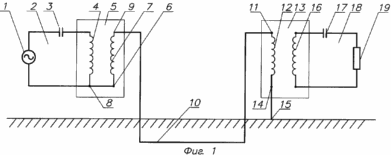 |
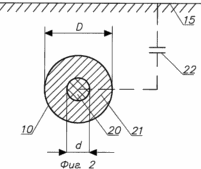 |
FIG. 1 shows a flowchart of a method and apparatus for transmitting electric power over a single-conductor subterranean waveguide; FIG. 2 is a cross-sectional view of a single-conductor waveguide.
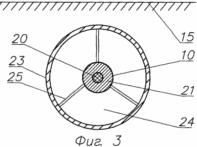 |
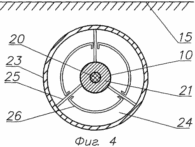 |
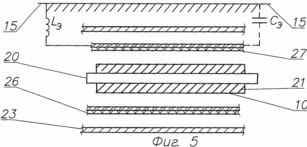 |
FIG. 3 is a cross-sectional view of a subterranean single-conductor waveguide with a cylindrical hollow dielectric sheath; FIG. FIG. 4 is a cross-sectional view of an underground single-conductor waveguide with an electrostatic shield; FIG. FIG. 5 is a diagram of the connection of the electrostatic shield to the inductance coils and the capacitance.
1, the electric high-frequency generator 1 generates resonant oscillations in a series resonant circuit 1 consisting of a capacitance 3 and a low-voltage winding 4 of a high-voltage Tesla transformer 5. One of the terminals 6 of the high-voltage winding 7 adjacent to the low-voltage winding is connected to the low-voltage winding terminal 8 4, and the other terminal 9 of the high-voltage winding is connected to the underground single-conductor electrically insulated waveguide 10. At the electrical energy consumer, the single-conductor waveguide 10 is connected to the internal terminal 11 of the high-voltage winding 12 of the Tesla 13 lowering high-voltage transformer. Another terminal 14 of the high-voltage winding 12 is connected to ground 15. The low-voltage winding 16 of the transformer 13 and the capacitance 17 form a receiving resonance circuit 18 which is connected to the load 19.
FIG. 2 is a cross-sectional view of a single-conductor waveguide 10 installed under ground 15 or under water. The waveguide consists of a metallic multifilamentary conductor 20, windings 21 of an insulating material, for example, of cross-linked polyethylene. To reduce the current loss through the capacitive resistance 22 of the waveguide 10 with respect to the ground 15, the ratio of the diameter D of the outer shell of the waveguide 10 and the diameter d of the metallic multifilamentary conductor 20 is D / d = 5-10.
3 is a cross-sectional view of a single-conductor waveguide 10 placed under the ground 15 or under water, axially symmetric in a hollow cylindrical shell 23 of an electrically insulating material, for example, cross-linked polyethylene or fiberglass. The single-conductor waveguide 10 consists of a metallic multifilamentary conductor 20 and a sheath 21 of electrical insulating material. The space 24 between the single-conductor waveguide 10 and the hollow cylindrical shell 23 is filled with an electrically insulating gas, for example SF6 gas, at a pressure of 1-10 kg / cm2. The waveguide 10 is fixed at the center of the hollow cylindrical shell 23 by means of dielectric stops 25.
FIG. 4 shows a cross-section of a single-conductor waveguide 10 mounted underground 15 or under water axisymmetrically by dielectric stops 25 in a hollow cylindrical shell 23 of an electrically insulating material. In the space between the waveguide 10 and the sheath 23, non-closed electrostatic shields 26 are isolated from each other from a metal sheet or grid. The screens are fixed to dielectric stops 25 and have a length of 1-1000 m. The total length of all screens is equal to the length of the underground part of the waveguide 10.
FIG. 5 shows a connection diagram of electrostatic shields 26 of an underground waveguide with inductance coils L e , which serve to compensate for the capacitance of the screen C e . The screens 26 are placed on the outer surface of an additional cylindrical shell 27 of electrically insulated material, for example, of cross-linked polyethylene or fiberglass, and are housed within the main hollow dielectric cylindrical shell 23.
The device works as follows.
Generator 1 generates an electric current of increased frequency 50 Hz - 50 kHz. In a series resonant circuit 2 at a resonance frequency of 50 Hz to 50 kHz, voltage on the inductance of the low-voltage winding 4 of the Tesla transformer 5 is increased. The voltage increase in the winding 4 compared to the voltage V o of the generator 1 is QV o , where Q is the quality factor of circuit 2. This The voltage is increased by n times in the high-voltage winding 7 of the Tesla transformer 5, where n is the transformation ratio. Thus, the total voltage U 2 on the internal terminal 9 of the high-voltage winding 7 will be V 2 = ![]() QU 0 n, where
QU 0 n, where ![]() - the coupling coefficient of the windings 4 and 7, 0 <
- the coupling coefficient of the windings 4 and 7, 0 < ![]() <1.
<1.
At pin 6 of the high-voltage winding 7, there is a current curvature and a voltage node, and this terminal 6 is connected to the terminal 8 of the low-voltage winding 4. Voltage and current with a phase shift of 90 ° from terminal 9 of the high-voltage winding 7 are fed to a single-conductor waveguide 10 and transmitted via a Tesla transformer 13 Into the resonant circuit 18. The total length L AB of the waveguide 10 and the high-voltage windings 7 and 12 of the two transformers must be an integer number of half-waves: n · ![]() / 2 = L AB , where
/ 2 = L AB , where ![]() =
= ![]() / F. For f = 1 kHz,
/ F. For f = 1 kHz, ![]() = 300 km, L Abmin = 150 km. To reduce the capacitance in the waveguide 10 with respect to the Earth 15, the diameter d of the metallic conductor 20 of the waveguide 10 is reduced and the diameter D of the insulating jacket 21 of the waveguide 10 is increased to a ratio D / d = 5-10. Thus, the transmission of electrical energy occurs between two resonant circuits along the waveguide communication line, and the role of Tesla 5 and 13 transformers is reduced to creating a non-symmetry of the potentials at terminals 9 and 11. On the surface of a single-conductor waveguide, due to the presence of a phase shift between the current and voltage waves There are surface charges that create Coulomb excitation electric fields, and these fields lead to the appearance of Coulomb currents in the conductor. A potential electric field appears in the conductor, which ensures charge transfer and current in the waveguide. The described processes have an electrostatic nature and are accompanied by small losses in the waveguide. Surface charges in a single-conductor waveguide change in time and create in the space surrounding the conductor a bias current that is closed by a current in a conductor excited by a potential electric field. The displacement currents, unlike the conduction currents, are not accompanied by the release of Joule heat (Tamm, EI, Fundamentals of the theory of electricity .- Moscow: Nauka, 1976, p.133, 397-400. Sotnikov VV Sources of the Coulomb field in conductors And their influence on the electric current, Izvestia, RAS, Energetics, 2002, No. 7, p.104-111).
= 300 km, L Abmin = 150 km. To reduce the capacitance in the waveguide 10 with respect to the Earth 15, the diameter d of the metallic conductor 20 of the waveguide 10 is reduced and the diameter D of the insulating jacket 21 of the waveguide 10 is increased to a ratio D / d = 5-10. Thus, the transmission of electrical energy occurs between two resonant circuits along the waveguide communication line, and the role of Tesla 5 and 13 transformers is reduced to creating a non-symmetry of the potentials at terminals 9 and 11. On the surface of a single-conductor waveguide, due to the presence of a phase shift between the current and voltage waves There are surface charges that create Coulomb excitation electric fields, and these fields lead to the appearance of Coulomb currents in the conductor. A potential electric field appears in the conductor, which ensures charge transfer and current in the waveguide. The described processes have an electrostatic nature and are accompanied by small losses in the waveguide. Surface charges in a single-conductor waveguide change in time and create in the space surrounding the conductor a bias current that is closed by a current in a conductor excited by a potential electric field. The displacement currents, unlike the conduction currents, are not accompanied by the release of Joule heat (Tamm, EI, Fundamentals of the theory of electricity .- Moscow: Nauka, 1976, p.133, 397-400. Sotnikov VV Sources of the Coulomb field in conductors And their influence on the electric current, Izvestia, RAS, Energetics, 2002, No. 7, p.104-111).
Therefore, the current density in a single-conductor waveguide 10 is 10-100 times higher than the current density in conventional cable lines and can be 10-500 A / mm2. The minimum diameter of the conductor 20 of the waveguide is selected from the mechanical strength condition of 1 mm. The maximum voltage for the waveguide in FIG. 2 is 10 6 V, for waveguides in FIGS. 3 and 4, 10 7 V. The resonant frequency of the underground transmission of electrical energy is 50 Hz-50 kHz at the optimum frequency of 150-1500 Hz. The maximum length of the waveguide is 20,000 km and is limited by radiation losses and leakage currents through the capacitance of the conductor 20 of the waveguide 10 with respect to the Earth. These losses decrease with decreasing frequency to 150-1500 Hz. The loss for the emission of a line of 20,000 km length is determined by the formula:

Where n is the number of half-waves;
I eff is the effective current in the line.
We take the effective current in the line I eff = 3000 A, the voltage U = 10 6 B, the power P l = 3000 × 10 6 kW, the frequency f = 0.6 kHz, the wavelength ![]() = 500 km, the number of half-waves at the line length n = 80. Calculation by the formula gives P = 2245.4 kW or in relative units:
= 500 km, the number of half-waves at the line length n = 80. Calculation by the formula gives P = 2245.4 kW or in relative units:
![]()
If SF6 gas is used at a pressure of 1-10 kg / cm and the construction of the waveguide 10 according to FIGS. 3 and 4, the maximum voltage on the waveguide will be 10,000 kV. The electrostatic shielding of the electric field of the waveguide 10 according to FIG. 4 will significantly reduce the influence of the Earth 15 or water on the energy loss. To reduce the capacitance of shields 26 and waveguide 10 relative to Earth 15, screens 26 are connected to Earth 15 by inductance L e . The inductance value L e is chosen from the condition:

Where C e is the capacitance of the screen 26 with respect to the Earth, and af is the resonance frequency.
The considered method and design of the device allow the transfer of the terawatt electric power flows between the continents of the Earth at the maximum, and reduce the dependence of the power supply on the weather conditions.
CLAIM
1. A method for transmitting electrical energy, comprising: converting electrical energy by voltage and frequency to an electric generator, transmitting electrical energy through a high voltage line, and converting electrical energy by voltage and frequency to a consumer, characterized in that electrical energy is transmitted under the ground or under water In resonant mode at a resonance frequency of 50 Hz - 50 kHz and a voltage of 1-1000 kV, current density of 1-500 A / mm on a single-conductor insulated cable.
2. A method for transmitting electrical energy, comprising: converting electrical energy by voltage and frequency to an electric generator, transmitting electrical energy through a high-voltage line, and converting electrical energy by voltage and frequency to a consumer, characterized in that electrical energy is transmitted under ground or under water in Resonant mode at a resonant frequency of 50 Hz - 50 kHz and a voltage of 1-1000 kV, current density of 1-500 A / mm 2 for a single electrically insulated axisymmetric and single-conductor waveguide inside a sealed hollow dielectric cylindrical channel in an atmosphere of isolated gas.
3. The method for transmitting electrical energy according to claim 2, characterized in that the transmission of electric energy through the waveguide is carried out in an atmosphere of SF6 gas at a pressure of 1-10 kg / cm 2 .
4. A method for transmitting electrical energy, comprising: converting electrical energy by voltage and frequency to an electric generator, transmitting electrical energy through a high voltage line, and converting electrical energy by voltage and frequency to a consumer, characterized in that electrical energy is transmitted at a frequency of 50 Hz to 50 kHz And a voltage of 1-10000 kV, a current density of 1-500 A / mm 2 over a single electrostatically shielded and electrically insulated axisymmetric single-conductor waveguide of a surface wave inside a hollow cylindrical screen and a sealed dielectric channel in an atmosphere of insulated gas.
5. An apparatus for transmitting electrical energy, comprising: a frequency converter and a resonant circuit of a step-up transformer, a high-voltage line, a resonant circuit of a step-down transformer and a load, characterized in that the high-voltage line is made underground or under water in the form of an electrically insulated single-conductor multi- , Section 0.01-1000 cm 2 , in which the cable diameter is 5-100 times the diameter of the conductor.
6. An electric power transmission device according to claim 5, characterized in that the waveguide is made of an insulated cable with an insulation thickness of 3-300 mm.
7. An apparatus for transmitting electric power, comprising: a frequency converter and a resonant circuit of a step-up transformer, a high-voltage line, a resonant circuit of a step-down transformer and a load, characterized in that the high-voltage line is made underground or under water in the form of a single-conductor waveguide 1-20,000 km in length, 0.01-1000 cm 2 , mounted axially symmetrically inside a pipeline with a diameter of 0.02-10 m made of a dielectric material, for example polyethylene or fiberglass.
8. An apparatus for transmitting electrical energy according to claim 7, characterized in that the waveguide is made of an insulated cable with an insulation thickness of 3-300 mm.
9. An apparatus for transmitting electrical energy according to claim 7, characterized in that the space between the waveguide and the pipeline is filled with electrically insulating gas under pressure, for example SF6 gas.
10. An apparatus for transmitting electrical energy, comprising a frequency converter, a resonant circuit of a step-up transformer, a high-voltage line, a resonant circuit of a step-down transformer and a load, characterized in that the high-voltage line is made as a single-conductor waveguide with a length of 1-20000 km, section 0.01-1000 Cm, mounted axially symmetrically inside a pipeline of 0.02-10 m in diameter from a dielectric material, and comprises an electric screen made in the form of a plurality of electrically insulated, open, conductive cylindrical shells whose total length is equal to the length of the waveguide, and the length of the conductive shells is 1-1000 m .
11. An apparatus for transmitting electrical energy according to claim 10, characterized in that each shell of the electric screen is connected to the ground by an inductance coil.
print version
Publication date 17.02.2007gg




Comments
When commenting on, remember that the content and tone of your message can hurt the feelings of real people, show respect and tolerance to your interlocutors even if you do not share their opinion, your behavior in the conditions of freedom of expression and anonymity provided by the Internet, changes Not only virtual, but also the real world. All comments are hidden from the index, spam is controlled.